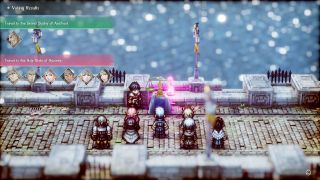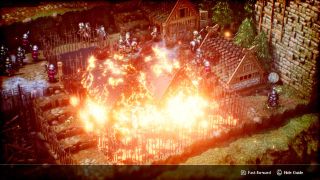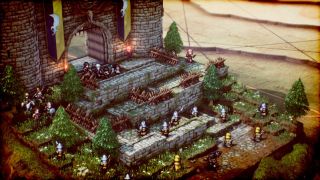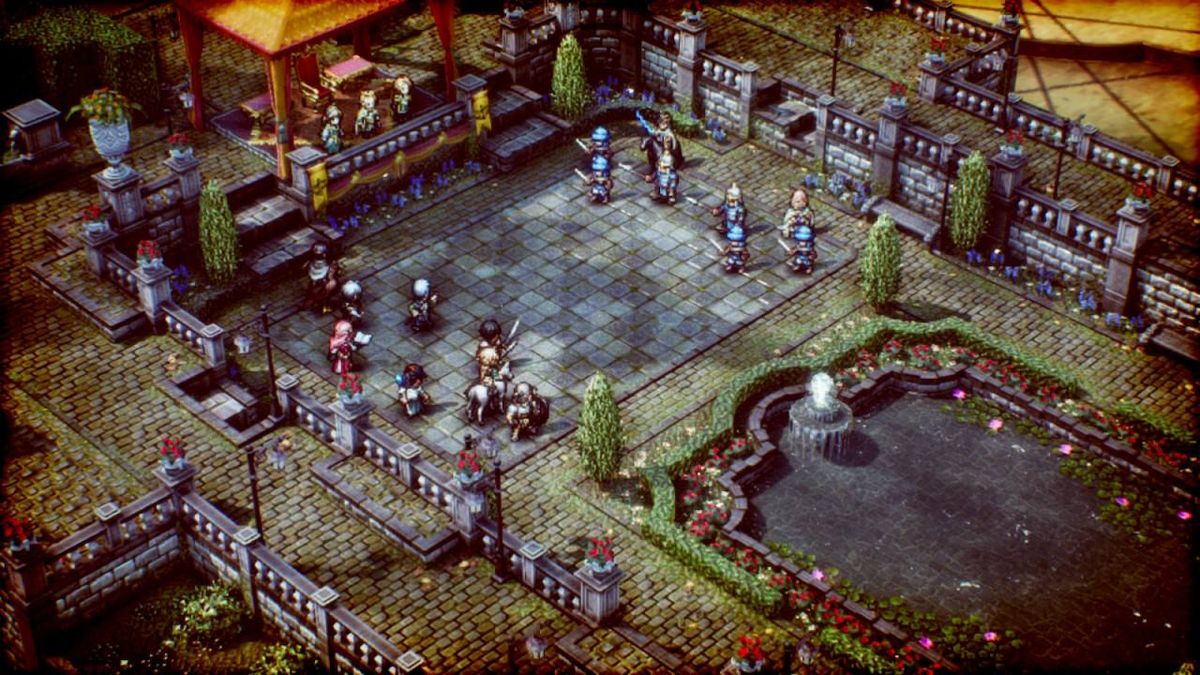Laptop Mag Verdict
For tactical RPG fans Triangle Strategy’s combat will satisfy the strategic itch. However, it may not scratch much outside of that.
Pros
- +
Smart, engaging tactical combat
- +
Branching Storylines
- +
Beautiful art style
- +
Nostalgic inspirations from older Square Enix tactical RPGs
Cons
- -
Flat characters
- -
Dragging storyline
- -
Lacking amount of battles
- -
Incredibly slow start
Why you can trust Laptop Mag
One look at Triangle Strategy and Square Enix’s cult tactical RPGs will immediately come to mind. The days of Final Fantasy Tactics on the PS1 or huddling over your PSP to play Tactics Ogre are purposefully evoked in the nostalgic gameplay and visual design of Triangle Strategy. This has been the goal of HD-2D-style games led by Team Asano at Square Enix. Octopath Traveler was a spiritual successor to Final Fantasy VI, and with Triangle Strategy, Team Asano and ArtDink have effectively made their dream sequel to Final Fantasy Tactics.
However, since the release of these older titles, the tactical RPG genre has changed with the success of character-focused gameplay and environmental systems in games like Fire Emblem: Awakening and Divinity: Original Sin. Unfortunately, Triangle Strategy aims for the heights of its predecessors while attempting to implement classic Square Enix tactical combat and character interactions outside of battles. As a result, the whole game feels too restrained in any part to feel like it holds its own against its spiritual predecessors.
Games that nations play
Every medieval fantasy strategy role-playing game (SRPG) starts with a nation. It’s an easy narrative device to make use of, as the genre is rooted in wargaming where traditionally opposing armies of military units are positioned against each other for players to battle. SRPGs evolve this formula by creating a dramatic story to parallel the war, and spend time fleshing out the characters involved within.
In Triangle Strategy we follow the events of the continent Norzelia after 30 years of post-war repair. Within Norzelia are the three nations of Aesfrost, Hyzante and Glenbrook (home of the protagonist). In the Saltiron War, each nation faced off in a conflict over the continent’s scarce salt. Despite the war’s end, tensions remain, which leads to the game’s main story of political intrigue involving betrayals, coups and hidden identities. The player follows the protagonist Serenoa, who takes on the mantle as lord of House Wolffort of Glenbrook just as Aesfrost is attempting to overthrow peace between nations.

Unfortunately, Triangle Strategy doesn’t offer any deep criticism about the way these systems function. Instead, it tries to position these events as a series of clichés designed to provide context to the characters. However, with the way Triangle Strategy is written, these attempts fail to create an emotional response beyond confusion. Much of the story is delivered via dialogue between government figures talking about the history of the continent, fathers and religion, and honor and glory. But these interactions are written in an unconvincing way. Royal figures will speak lines such as, “It’s clear that all people are not to be treated equal!” or “If I sacrifice myself, no one else will be killed.” It sounds comical because it attempts to paint the characters as honorable or oppressive through blatant speech as opposed to showing how the system upholds those people and is built to oppress. It’s hard to care about what's going on when there isn’t any investment beyond exposition.
There isn’t much more going on with the characters in your party, either. Cutscenes take up as much time as combat does, but it is filled with niceties and repeated sentiments before the plot moves forward. The time that characters have to bond with one another and present us with new parts of themselves isn’t given enough air. Serenoa watches his father lay dying and his best friend’s kingdom fall, but rarely shows emotional vulnerability and instead is stoically bold, saying, “we must stick together and fight on.” The only character who really stood out was Roland, the prince of the fallen Whiteholm Castle, as he deals with themes of guilt, identity and revenge. Though, I found myself still frustrated with his repeated loss of the bigger picture.
This overt dressing of the world’s politics isn’t limited to the dialogue. Triangle Strategy lacks sensitivity in the way it conceptualizes the people of the world and their cultures. The biggest example of this is the Rosellian people, who are discriminated against for their pink hair. In the first half of the game, the Roselle are discriminated against without explanation. Later on, the Roselle are revealed to be detained in labor camps due to the religious belief that they will hoard the world’s salt. Triangle Strategy attempts to develop the story of these people to give them nuance. Yet this fails because the Roselle’s construction are insensitively inspired by the real world pains of holocausts throughout history. Triangle Strategy attempts to fill its world with thematic hardship via a tool that provides trauma without context.
A rock and a hard place
The primary way Triangle Strategy expresses the ideals of the characters is through “convictions.'' These are the values that your character develops over the course of your decisions, which are shaped by three ideals: utility, morality, and liberty. At any point in the game, you’ll be notified when these values are affected. Most of the decisions will come through the dialogue choices made during cutscenes and exploration sessions. However, when you finish a mock battle for grinding, you can still receive the telltale-like notification that your convictions have changed.

Disappointingly, these convictions feel very disconnected from the game. Convictions are meant to determine which characters join your party and other parts of the story, but the characters' stories and dialogue are so lightweight that there isn’t an indication that your actions influenced anything. The conviction system is less like a branching series of choices with consequences, and more like arbitrary conditions to receive certain unlocks with a pointless indicator showing up after every event.
These convictions parallel the other narrative mechanic, “the scales of conviction.” Every couple of chapters the characters will run into a dilemma that they can’t all come to an agreement on. Instead of asking the player to decide what direction they should take, they vote on a decision by placing anonymous stones onto a scale. I found myself appalled by how ridiculous some of the decisions were.
“We can choose to flood an entire city of people or sneak in at night to take out their generals in order to not harm the people at all.”
“Well we can receive aid to rebuild our home from the religious country, but we have to move the historically oppressed people living in our nation’s protection to the religious country’s labor camps.”
These decisions offer naive ideas about the way governments make decisions and perceive harm. It propagates Triangle Strategy’s idea that a “good” government does not make decisions to harm its people, but only harms them as a side effect of not being able to satisfy anyone.

Sometimes these decisions don’t even play out the way you hoped. When I made a decision in order to stand strong for my values, I was shocked that it didn’t matter anyway. People still died when I decided on more difficult situations that would keep them alive. My party members continued to desire to give up on their roles, despite so many sacrificing themselves to go on. This is because the primary overarching plot is prioritized over the branching narrative that the game can take.
If Triangle Strategy was a visual novel with these conviction/voting portions, I would likely never recommend it to anyone. However, outside of all this, the Square Enix tactics-inspired gameplay holds strong enough that it isn’t a total slog.
Pieces on the board
Despite the plot of the game, the combat in Triangle Strategy is incredibly enjoyable. It never reaches the heights of Final Fantasy Tactics, but it still features a well-designed series of strategy RPG fights. There are many aspects you will find familiar to other Square Enix tactical RPGs, like moving characters via grid in order to backstab or shoot an enemy from higher ground. However, Triangle Strategy has added more to the formula.
There is a lot more emphasis on where characters are placed. One of the simplest ways this has been iterated upon is by adding follow-up attacks, where placing an enemy between two characters can lead to additional attacks. What is even more rewarding, however, is the plot-based weapons and the skill-based interactions within the environment. Decisions made throughout the game can influence the battlefield, like finding story-related weapons scattered across the board. Another instance was during one of the critical battles of my playthrough; it involved strategically manipulating groups of enemies to gather into squares that I could lock them into and set them on fire. These moments never feel gimmicky, as they aren’t overused, and are rather satisfying in the face of overwhelmingly powerful enemies that appear throughout the game.
There aren’t classes that characters can switch between like Final Fantasy Tactics. However, each character has a series of abilities and traits that parallel those classes. For example, the protagonist, Serenoa, is a knight that has abilities utilizing his sword and counters. I also recruited an apothecary that allowed me to use items twice per turn and throw them at long-range. Another personal favorite was the mechanic, who created spring traps on the ground to throw enemies. While there is less progression per character than I would have liked, it’s not a glaring issue.

However, a frustrating aspect of the gameplay is that there isn’t enough content in the game to make the combat shine. Playing through the story, there are moments where conflicts in the narrative align with spectacular enemy battles. During these fights, I found myself deeply satisfied in the act of reloading each time to rethink when my strategies failed me in the face of a difficult battle. But there are only a few of these moments sprinkled throughout the game. Outside of the story, the only other battles are mock battles the player can use to practice. I found these equivalent to the story fights in terms of excitement, difficulty, and strategy. However, as the player progresses further in the game, the narrative asks for the characters to grind the same mock battle at the tavern over and over to reach the correct level for a fight because there is only one side battle offered per chapter. In my playthrough, I was grinding through the same fight three to five times in the back half of the game just so I could reach the recommended level for the next story beat.
Bottom line
When finishing Triangle Strategy, I couldn’t help but wonder why the game felt so constrained. There is a lot of creativity in the voting system, the convictions, and the combat. However, there is a lack of content to utilize the battle system outside of the main story, and the plot itself ended up being a large disappointment. By the end of the game, I had turned off the music from grinding out mock battles so much and wanted so badly to just skip cutscenes in order to get more of the gameplay. I had lost all interest in the characters after they declined to grow from the beginning of the game.
Triangle Strategy is not the next coming of Final Fantasy Tactics or Tactics Ogre, but it does scratch a similar tactical itch. In the midst of feeling exhausted by the cutscenes and grinding, the main story battles always returned feelings of deep thought and ideating strategies. For those who are coming for that exact feeling, and are less interested in what the narrative has to offer, Triangle Strategy might be for you.

